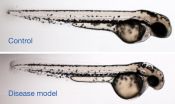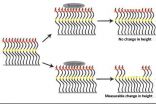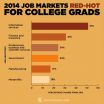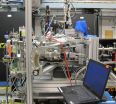(Press-News.org) ITHACA, N.Y. – Cornell University researchers have uncovered details of how the deadly Middle East respiratory syndrome coronavirus (MERS-CoV) enters host cells, and offer possible new avenues for treatment.
The study, appearing online this month in the Proceedings of the National Academy of Sciences, discovered that a common protease enzyme known as furin activates the MERS-CoV to fuse with cell membranes and enter host cells.
The researchers, Gary Whittaker, Cornell professor of virology, and Jean Millet, a postdoctoral associate in Whittaker's lab, suggest that blocking furin at a specific point in the host cell entry process could lead to a treatment by preventing the virus from getting into cells, where it uses the cell's reproduction mechanism to make new viruses.
Coronaviruses have a spike protein that is activated by a protease and mediates membrane fusion and entry into a host cell. The location on the spike protein where a protease activates this process is called a cleavage site.
The researchers found there were two cleavage sites for MERS-CoV, each activated by furin at different times: after a new virus is assembled inside a host cell, when the virus makes its way out of the host cell to the cell surface, and again, when the released virus finds a new cell and is taken up into the membrane.
"This is the first characterization of a natural coronavirus with a spike protein containing two furin cleavage sites," said Millet, the paper's first author.
"It might be a situation where that extra cleavage site is allowing more spread in the animal or human," said Whittaker. With MERS, "the primary infection is in the lungs, and even there it infects additional cell types," including immune cells, which could allow dissemination throughout the body, he added.
One way viruses mutate is by changing the protease they use for activation. "This study shows how flexible coronaviruses are in terms of cleavage activation strategies," said Millet. "They are extremely adaptable."
The researchers suspect that a MERS-CoV in camels may have mutated two and half years ago, allowing the virus to infect humans. At present, the virus does not spread easily between people, except during hospital-acquired outbreaks.
Societies in North Africa and the Middle East have strong cultural connections to camels, where "there are a lot of activities that expose people to raw camel products – milk, urine – which could be the root of infection to humans," said Whittaker.
INFORMATION:
Cornell University has television, ISDN and dedicated Skype/Google+ Hangout studios available for media interviews.
Study reveals how deadly MERS virus enters human cells
2014-10-14
ELSE PRESS RELEASES FROM THIS DATE:
Turtle tumors linked to excessive nitrogen from land-based pollution
2014-10-14
Hawai'i's sea turtles are afflicted with chronic and often lethal tumors caused by consuming non-native algae "superweeds" along coastlines where nutrient pollution is unchecked. The disease that causes these tumors is considered the leading cause of death in endangered green sea turtles. The new research was just published in the scientific journal PeerJ.
Turtles that graze on blooms of invasive seaweeds end up with a diet that is rich in a particular amino acid, arginine, which promotes the virus that creates the tumors. Scientists at the University of Hawai'i at Mānoa ...
QUT study helps outdoor workers reduce their skin cancer risk
2014-10-14
Skin cancer is one of the biggest fears for one in two outdoor workers and when the boss and staff work together the sun safe message gets through, a QUT study has found.
The study, which found more than 50 per cent of outdoor workers rated UV radiation exposure at work as one of their biggest concerns, also identified how a workplace intervention could improve workers' behaviours and attitudes towards sun protection to reduce their risk of skin cancer.
QUT in collaboration with Cancer Council Queensland and Curtin University worked with 14 Queensland outdoor workplaces ...
Mediterranean diet, olive oil and nuts can help reverse metabolic syndrome
2014-10-14
For people with metabolic syndrome, a Mediterranean diet supplemented with extra-virgin olive oil or nuts may help reverse the condition, indicate findings from a clinical trial published in CMAJ (Canadian Medical Association Journal).
About 25% of adults around the world have metabolic syndrome. The syndrome exists in the presence of three or more factors such as large waist circumference, high blood pressure, low HDL-cholesterol, high levels of triglycerides and high blood sugar concentrations that can increase the risk of diabetes, heart disease and death.
Spanish ...
For one family, zebrafish help provide genetic answers
2014-10-14
Research in zebrafish has helped identify the cause of an unknown genetic disorder affecting a boy and two of his uncles, scientists report in an article published October 14 in the journal Genetics.
The findings demonstrate the growing importance of zebrafish as laboratory models of rare diseases. Such models allow geneticists to make sense of the deluge of candidate disease genes being uncovered by advances in sequencing technologies. Although rare diseases are uncommon individually, together they affect as many as 25 million people in the United States.
The project ...
Side effects of cancer prevention surgery can be helped with education program
2014-10-14
BOSTON –– More women are having ovary-removing surgery as a cancer prevention measure, but many are often unaware of sexual or psychological side effects of the procedure. A new study by researchers at Dana-Farber Cancer Institute shows a half-day educational program can help successfully deal with these issues by educating women on how to address them.
The program taught women how to manage some of the physical and emotional difficulties that can follow ovary-removing surgery and helped many participants resume satisfying sexual activity and reduce feelings ...
Scientists create new protein-based material with some nerve
2014-10-14
Berkeley — Scientists at the University of California, Berkeley, have taken proteins from nerve cells and used them to create a "smart" material that is extremely sensitive to its environment. This marriage of materials science and biology could give birth to a flexible, sensitive coating that is easy and cheap to manufacture in large quantities.
The work, to be published Tuesday, Oct. 14, in the journal Nature Communications, could lead to new types of biological sensors, flow valves and controlled drug release systems, the researchers said. Biomedical applications ...
Feeling guilty or ashamed? Think about your emotions before you shop
2014-10-14
Suppose you grabbed a few cookies before heading out to the grocery store and start to feel guilty or ashamed about breaking your diet. According to a new study in the Journal of Consumer Research, feeling guilty might find you comparing calories in different cartons of ice cream. Feeling ashamed might keep you from buying any ice cream in the first place.
"We examined the emotions of guilt and shame and found that when consumers feel guilty, they tend to focus on concrete details at the expense of the bigger picture. On the other hand, when consumers feel ashamed, they ...
Marketing an innovative new product? An exciting product launch could hurt sales
2014-10-14
Should every successful product launch involve some sort of dazzling spectacle? A new study in the Journal of Consumer Research tells us that this might be a great way to market an upgrade, but a flashy launch could backfire if a new product is truly innovative.
"The accepted wisdom is that consumers get excited about new and unique products they cannot immediately understand. However, these feelings of excitement can quickly change to tension and anxiety if we can't ultimately make sense of what a product does, especially if we are in a stimulating retail environment," ...
Jobs plentiful for college grads
2014-10-14
EAST LANSING, Mich. — The job market for new college graduates is red hot.
After several years of modest growth, hiring is expected to jump a whopping 16 percent for newly minted degree-holders in 2014-15, according to key findings from Recruiting Trends. The annual survey, by Michigan State University economist Phil Gardner, is the nation's largest with nearly 5,700 companies responding.
"Employers are recruiting new college graduates at levels not seen since the dot-com frenzy of 1999-2000," said Gardner, director of MSU's Collegiate Employment Research Institute. ...
New light on the 'split peak' of alcohols
2014-10-14
WASHINGTON D.C., October 14, 2014 -- For scientists probing the electronic structure of materials using a relatively new technique called resonant inelastic soft X-ray scattering (RIXS) in the last few years, a persistent question has been how to account for "split peak" spectra seen in some hydrogen-bonded materials.
In RIXS, low-energy X-rays from synchrotron or X-ray free-electron laser light sources scatter off molecules within the studied material. If those molecules include light elements, such as the -OH group in alcohols, the complex spectra RIXS produces are ...




